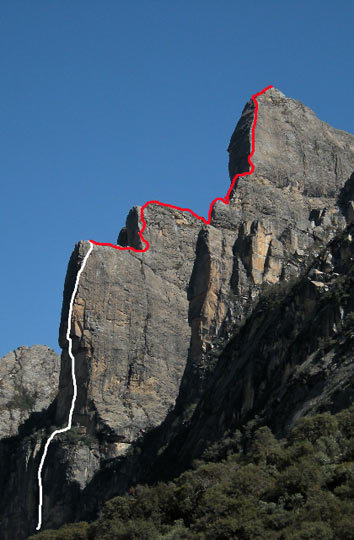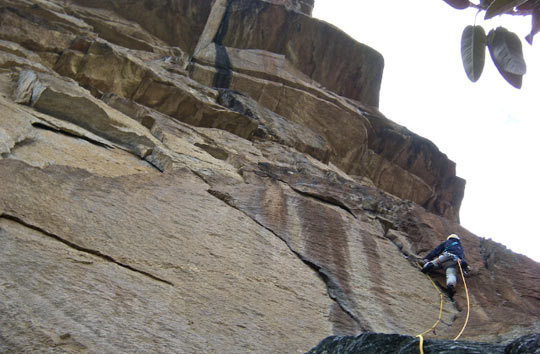
Karma de Los Condores (IV 5.11d, 9 pitches, 2005), marked in white, and an extension (five additional pitches, up to 5.11c) recently climbed by Dave Anderson and Brady Robinson marked in red, Hatun Ulloc, Cordillera Blanca, Peru. The Americans were first to climb the final headwall. [Photo] Dave Anderson collection
On July 21, 2008, Brady Robinson and I flew to the town of Huaraz located in the heart of Peru’s Cordillera Blanca. Earlier in the summer I had received an email from Brady asking if I had interest in going on a short climbing trip. Eight years ago we were both working as climbing guides, and the flexibility of that lifestyle had allowed us to explore the mountains on a regular basis. Now our lives were filled with self-induced responsibilities, and Brady had only two weeks for the adventure. We decided on two climbing objectives: a new alpine rock route and, if there were time, a classic alpine face.
The only granite peak we knew of in Peru was La Esfinge located in the Paron Valley, but after some research we learned the area had been visited by many strong parties including Leo Holding, Silvo Karo and Josh Wharton. The chances of me and Brady discovering a new crack line within our climbing ability seemed rather unlikely. After a Google search, I came across an Alpinist NewsWire about rock climbing in the Quebrada Ishinca Valley. This valley is well known to climbers for its classic alpine routes, but in 2005 Americans Wayne Crill and Kevin Gallagher had freeclimbed Karma de Los Condores (IV 5.11d, 9 pitches) up the steep first tier of a rock feature called Hatun Ulloc (aka Ishinca Tower). Several parties had since climbed the route, but none had yet reached the summit. I contacted Jeff Jackson, who had helped Crill and Gallagher establish Karma de Los Condores, and he described the route as “steep crack climbing, similar to Astroman in Yosemite. And if you’re motivated to clean cracks at 14,000-plus feet, there’s a great plum to be picked by finishing out the ridge.” So the choice was made, and we set off for the Ishinca Valley.
Our initial approach to climbing Hatun Ulloc involved classic mountaineering style: climb from the bottom to the top via the easiest line. We chose to ascend a gully to the east of the main formation in an attempt to access the northeast ridge, and hopefully the summit. The gully was the main drainage to the east of Hatun Ulloc, and as a result the climbing involved negotiating crackless polished granite slabs covered by a thick layer of moss and interspersed with teetering loose blocks. After some exciting “turf” climbing with nut tools we reached the col, and to our surprise the northeast ridge was shorter and easier than it looked from the base. Within twenty minutes we were standing on the summit of Hatun Ulloc. We then rapped down the final rock step to see if there were any crack systems. After some cleaning the line looked feasible except for the start, which involved 5.11 face climbing with a 25-foot ledge fall before reaching a crack system. After some debate we reluctantly placed one bolt and redpointed two pitches (5.11c and 5.9R) to the summit. We retuned to the base and fixed three rope lengths on Karma de Los Condores, onsighting all the pitches except the 5.11+ roof pitch before descending to camp.
After waiting out some poor weather we returned on July 29 and ascended to our high point. Brady fired the crux pitch with some of the gear in place, and we continued without incident to the summit to complete the extension of Karma de Los Condores, which ended up being fourteen pitches. Overall the rock quality was excellent, the climbing spectacular and the harder pitches were very well protected while some of the 5.9-5.10 pitches had significant runout.
With two days left in the Ishinca Valley, we moved our camp up to the end of the valley. The next day we simulclimbed the classic direct west face (D+) of Tocllaraju (6032m) in thirteen hours round trip from the lower base camp to complete two action-packed weeks in Peru.

Cruising up to the 5.11 roof section of Karma de Los Condores. [Photo] Dave Anderson collection